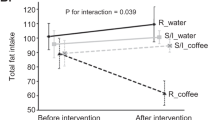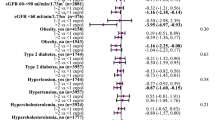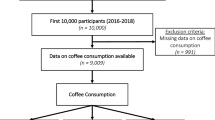Abstract
Background
Bioelectrical impedance analysis (BIA) is a widely used method for estimating body composition. Avoiding foods/beverages containing caffeine is a frequently enforced pre-test protocol to ensure reliability of BIA measurements. However, few studies have evaluated whether this is necessary, with conflicting results. We aimed to determine whether the coffee consumption differing in caffeine content influences BIA parameters in healthy adults.
Methods
Twenty-five healthy adults were enrolled in a randomized, double-blind cross-over trial. Three amounts of caffeine were given with 200 mL of coffee: 0 mg (11 g of decaffeinated), 200 mg (5.5 g of caffeinated plus 5.5 g of decaffeinated), and 400 mg of caffeine (11 g of caffeinated). BIA measurements were conducted at 6 different times, and coefficient variations (CV) explored.
Results
No differences were observed for group × time interaction on impedance, resistance, or reactance (p > 0.05). Values of BIA parameters increased after 30-min of coffee consumption, independently of the caffeine dosage (all p < 0.001). Body fat percentage followed the same pattern and increased after 45-min (p < 0.05). Median CV for consecutive impedance, resistance, and reactance measurements were >95%CI of expected device measurement error over 70-min, without difference between groups. Urine output volume was not different between groups (decaffeinated: 440.45 ± 197.57 mL; 200 mg: 471.80 ± 171.88 mL; 400 mg: 489.30 ± 204.10 mL, p > 0.05).
Conclusion
Coffee consumption influenced BIA-derived results after 70-min but was not related to caffeine content, likely due to water intake.
This is a preview of subscription content, access via your institution
Access options
Subscribe to this journal
Receive 12 print issues and online access
$259.00 per year
only $21.58 per issue
Buy this article
- Purchase on Springer Link
- Instant access to full article PDF
Prices may be subject to local taxes which are calculated during checkout




Similar content being viewed by others
References
Lee SY, Gallagher D. Assessment methods in human body composition. Curr Opin Clin Nutr Metab Care. 2008;11:566–72.
Lukaski HC, Vega Diaz N, Talluri A, Nescolarde L. Classification of hydration in clinical conditions: indirect and direct approaches using bioimpedance. Nutrients. 2019;11:809. https://doi.org/10.3390/nu11040809.
Bera TK. Bioelectrical impedance methods for noninvasive health monitoring: a review. J Med Eng. 2014;2014:381251.
Androutsos O, Gerasimidis K, Karanikolou A, Reilly JJ, Edwards CA. Impact of eating and drinking on body composition measurements by bioelectrical impedance. J Hum Nutr Diet. 2015;28:165–71.
Marx B, Scuvee E, Scuvee-Moreau J, Seutin V, Jouret F. Mechanisms of caffeine-induced diuresis. Med Sci. 2016;32:485–90.
Reyes CM, Cornelis MC. Caffeine in the diet: country-level consumption and guidelines. Nutrients. 2018;10:1772. https://doi.org/10.3390/nu10111772.
Blauch JL. HPLC determination of caffeine and theobromine in coffee, tea, and instant hot cocoa mixes. J Food Sci. 1983;48:745–7. Tarka Jr. SM
Stavric B. Methylxanthines: toxicity to humans. 1. Theophylline. Food Chem Toxicol. 1988;26:541–65.
Hackett J, Telepchak MJ, Coyer MJ. Analysis of total caffeine and other xanthines in specialty coffees using mixed mode solid-phase extraction and liquid chromatography-diode-array detection after microwave digestion. J Anal Toxicol. 2008;32:695–701.
Irons JGB, Bassett DT, Prendergast CO, Landrum RE, Heinz AJ. Development and initial validation of the caffeine consumption questionnaire-revised. J Caffeine Res. 2016;6:20–5.
Earthman CP. Body composition tools for assessment of adult malnutrition at the bedside: a tutorial on research considerations and clinical applications. J Parenter Enter Nutr. 2015;39:787–822.
Price KL, Earthman CP. Update on body composition tools in clinical settings: computed tomography, ultrasound, and bioimpedance applications for assessment and monitoring. Eur J Clin Nutr. 2019;73:187–93.
Kellum JA, Lameire N. Diagnosis, evaluation, and management of acute kidney injury: a KDIGO summary (Part 1). Crit Care. 2013;17:204.
McCusker RR, Goldberger BA, Cone EJ. Caffeine content of specialty coffees. J Anal Toxicol. 2003;27:520–2.
Dixon CB, Ramos L, Fitzgerald E, Reppert D, Andreacci JL. The effect of acute fluid consumption on measures of impedance and percent body fat estimated using segmental bioelectrical impedance analysis. Eur J Clin Nutr. 2009;63:1115–22.
Williamson CM, Nickerson BS, Bechke EE, McLester CN, Kliszczewicz BM. Influence of acute consumption of caffeine vs. placebo over Bia-derived measurements of body composition: a randomized, double-blind, crossover design. J Int Soc Sports Nutr. 2018;15:7.
Foster KR, Lukaski HC. Whole-body impedance-what does it measure? Am J Clin Nutr. 1996;64:388s–96s.
Kushner RF, Gudivaka R, Schoeller DA. Clinical characteristics influencing bioelectrical impedance analysis measurements. Am J Clin Nutr. 1996;64:423s–7s.
Dehghan M, Merchant AT. Is bioelectrical impedance accurate for use in large epidemiological studies? Nutr J. 2008;7:26.
Seal AD, Bardis CN, Gavrieli A, Grigorakis P, Adams JD, Arnaoutis G, et al. Coffee with high but not low caffeine content augments fluid and electrolyte excretion at rest. Front Nutr. 2017;4:40.
Armstrong LE, Pumerantz AC, Roti MW, Judelson DA, Watson G, Dias JC, et al. Fluid, electrolyte, and renal indices of hydration during 11 days of controlled caffeine consumption. Int J Sport Nutr Exerc Metab. 2005;15:252–65.
Killer SC, Blannin AK, Jeukendrup AE. No evidence of dehydration with moderate daily coffee intake: a counterbalanced cross-over study in a free-living population. PLoS One. 2014;9:e84154.
Silva AM, Judice PB, Matias CN, Santos DA, Magalhaes JP, St-Onge MP, et al. Total body water and its compartments are not affected by ingesting a moderate dose of caffeine in healthy young adult males. Appl Physiol Nutr Metab. 2013;38:626–32.
Maughan RJ, Griffin J. Caffeine ingestion and fluid balance: a review. J Hum Nutr Diet. 2003;16:411–20.
Zhang Y, Coca A, Casa DJ, Antonio J, Green JM, Bishop PA. Caffeine and diuresis during rest and exercise: a meta-analysis. J Sci Med Sport. 2015;18:569–74.
Lu HK, Chiang LM, Chen YY, Chuang CL, Chen KT, Dwyer GB. et al. Hand-to-hand model for bioelectrical impedance analysis to estimate fat free mass in a healthy population. Nutrients. 2016;8:654. https://doi.org/10.3390/nu8100654.
Bedogni G, Malavolti M, Severi S, Poli M, Mussi C, Fantuzzi AL, et al. Accuracy of an eight-point tactile-electrode impedance method in the assessment of total body water. Eur J Clin Nutr. 2002;56:1143–8.
Acknowledgements
We thank Nescafe Nestlé Canada for in-kind donation of the product. The company had no role in any aspect of the study.
Funding
The study was funded by Campus Alberta Innovates Program. JFM was supported by the National Council for Scientific and Technological Development (CNPq, n. 203886/2017–8) during the conduction of this study. JRBT was supported by the Brazilian Government through the Graduate Scholarship of CNPq and Emerging Leaders in the Americas Program supported by the Government of Canada.
Author information
Authors and Affiliations
Contributions
JFM, CT, and CMP: designed the research; JFM and JRBT: product acquisition; GLO and CT: performed data collection; JFM: performed the statistical analyses; HL, JFM, and MCG: analyzed and interpreted the data; JFM and JRBT: wrote the first draft of the manuscript; CMP, CT, GLO, HL, and MCG: reviewed the manuscript, contributed to the discussion. All authors were involved in editing the manuscript and read and approved the final manuscript.
Corresponding authors
Ethics declarations
Conflict of interest
The authors declare no competing interests
Additional information
Publisher’s note Springer Nature remains neutral with regard to jurisdictional claims in published maps and institutional affiliations.
Supplementary information
Rights and permissions
About this article
Cite this article
Mota, J.F., Gonzalez, M.C., Lukaski, H. et al. The influence of coffee consumption on bioelectrical impedance parameters: a randomized, double-blind, cross-over trial. Eur J Clin Nutr 76, 212–219 (2022). https://doi.org/10.1038/s41430-021-00932-3
Received:
Revised:
Accepted:
Published:
Issue Date:
DOI: https://doi.org/10.1038/s41430-021-00932-3
This article is cited by
-
Phase angle and cellular health: inflammation and oxidative damage
Reviews in Endocrine and Metabolic Disorders (2023)
-
Coffee consumption effects on bioelectrical impedance parameters: does gender matter?
European Journal of Clinical Nutrition (2022)



